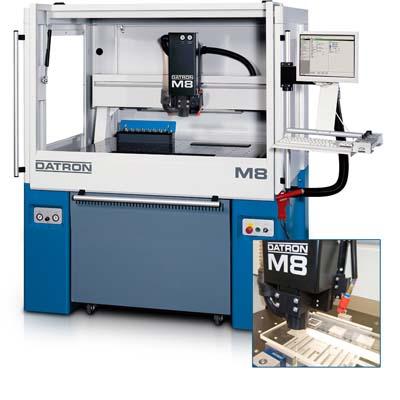
The DATRON M8 PlasticMill is a high-speed CNC machining center designed specifically for plastic machining applications that produce debris such as large and small chips or dust that must be extracted and collected. The M8 PlasticMill features a chip extractor surrounding the spindle that is plumbed to the exterior of the machine with conductive and grounded hosing that eliminates static. Powered by an industrial Ruwac vacuum system rated for continuous duty, the chip extractor removes slugs as they are milled free from the workpiece. This helps to protect the surface finish and quality of the machined part and minimizes post-machining clean up. With a 24 volt relay for ON/OFF, the vacuum system can be controlled within the program or at the machine control.
The M8 PlasticMill also has two integrated static-eliminating deionizers mounted on the sides of the spindle housing for management of plastic dust. By eliminating static, the dust can be evacuated through the chip extractor and collected outside of the machine, further reducing cleanup operations after machining. Positioned for the milling of engineered plastics, plastic sheet material and molded plastic parts, the M8 PlasticMill can be configured with integrated automation such as workholding and automatic doors and built-in safety sensors.
The M8 PlasticMill features a steel bridge reinforced with polymer concrete for superior stability and a 2kW (2 ¾ hp), water-chilled 60,000 RPM spindle for feed rates up to 20 meters per minute. A vibration-dampening, polymer-concrete machining table provides 40" x 30" work area while the over-all machine footprint is only 69" x 55". Automatic tool change options include up to 30-tool "station-style" rack with tool-length sensor. A stabilized gantry, integrated pneumatically covered tool magazine, LCD flat-panel display, polycarbonate side windows and a removable chip cart on wheels are just a few extra features that distinguish the M8 PlasticMill.
The Microsoft Windows-based controller works with virtually any CAD/CAM software and offers Ethernet networking capability, as well as remote monitoring and control, allowing the machine to seamlessly integrate into any manufacturing environment. Other available options include a Z-Correction Probe that measures surface irregularities and compensates for them dynamically, a 3D Probe Extension that enables Z-Correction Probe to function in 3D (X, Y and Z), a Renishaw TP20 Probe for complex part measurement, Vacumate and Quick-Pallets workholding for quick setup and a Digital I/O that provides 16 inputs and 16 outputs from the CNC.
Contact Details
Related Glossary Terms
- computer numerical control ( CNC)
computer numerical control ( CNC)
Microprocessor-based controller dedicated to a machine tool that permits the creation or modification of parts. Programmed numerical control activates the machine’s servos and spindle drives and controls the various machining operations. See DNC, direct numerical control; NC, numerical control.
- feed
feed
Rate of change of position of the tool as a whole, relative to the workpiece while cutting.
- gang cutting ( milling)
gang cutting ( milling)
Machining with several cutters mounted on a single arbor, generally for simultaneous cutting.
- machining center
machining center
CNC machine tool capable of drilling, reaming, tapping, milling and boring. Normally comes with an automatic toolchanger. See automatic toolchanger.
- milling
milling
Machining operation in which metal or other material is removed by applying power to a rotating cutter. In vertical milling, the cutting tool is mounted vertically on the spindle. In horizontal milling, the cutting tool is mounted horizontally, either directly on the spindle or on an arbor. Horizontal milling is further broken down into conventional milling, where the cutter rotates opposite the direction of feed, or “up” into the workpiece; and climb milling, where the cutter rotates in the direction of feed, or “down” into the workpiece. Milling operations include plane or surface milling, endmilling, facemilling, angle milling, form milling and profiling.
